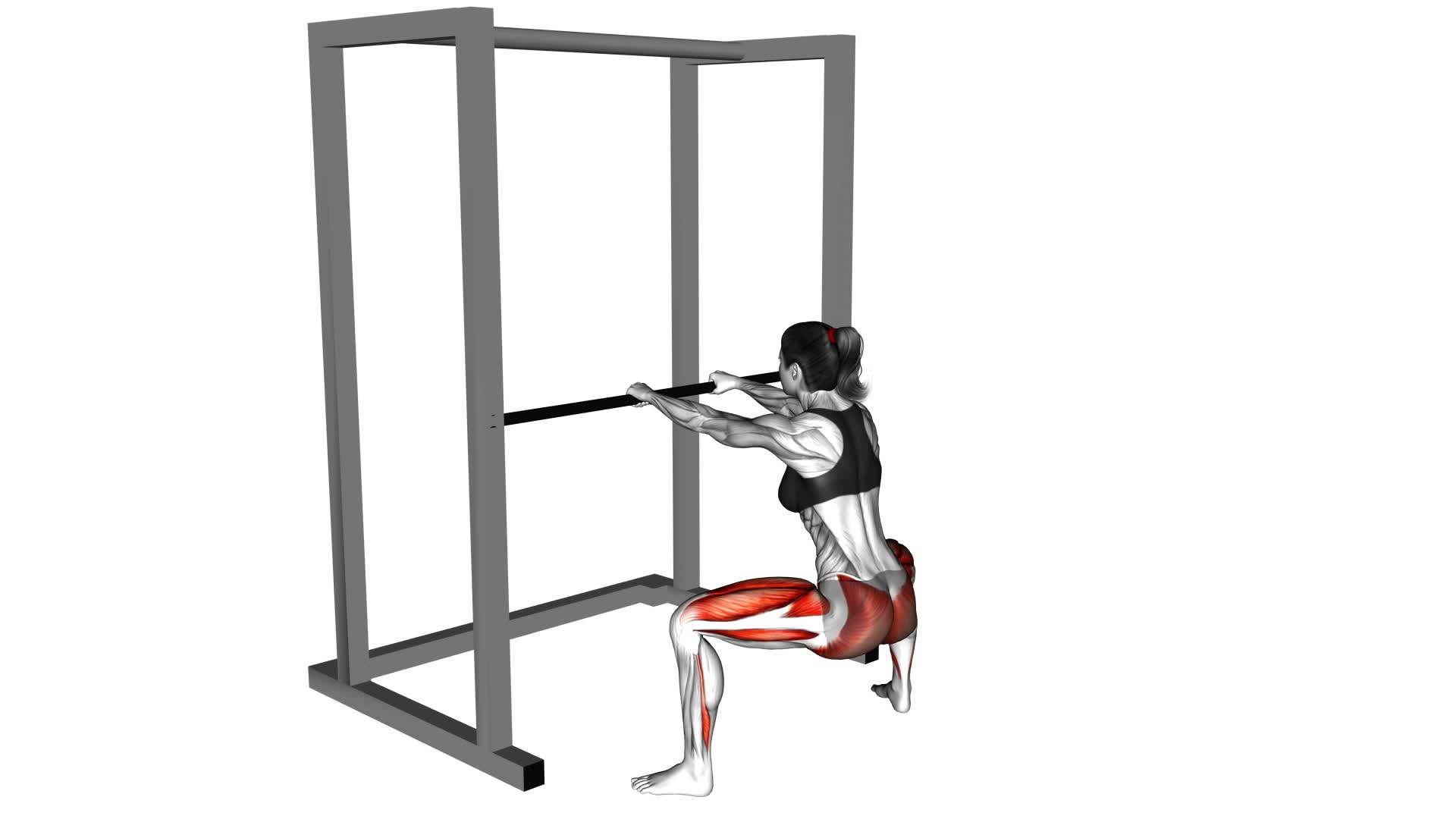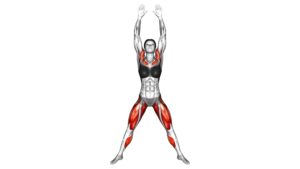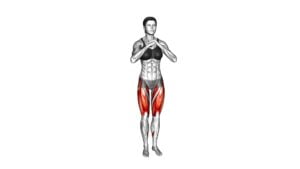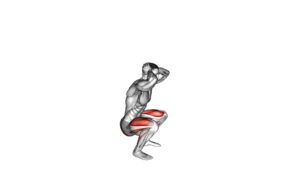Deep Sumo Squat Hold (female) – Video Exercise Guide & Tips

Get ready to strengthen your lower body with the deep sumo squat hold! This video exercise guide is designed specifically for female athletes like you. Learn the proper form and technique to maximize the effectiveness of this exercise.
Watch This Exercise Video
Avoid common mistakes, make modifications based on your fitness level, and get expert tips to take your workout to the next level.
Let's dive into the deep sumo squat hold and achieve your fitness goals together.
Key Takeaways
- Activates multiple muscle groups: quadriceps, hamstrings, glutes, and calves.
- Improves hip mobility and flexibility.
- Enhances core stability and balance.
- Increases muscle activation and development.
Benefits of the Deep Sumo Squat Hold
The deep sumo squat hold offers numerous benefits for improving lower body strength and flexibility. This exercise isn't only beneficial for athletes, but also for individuals looking to enhance their overall health and fitness.
One of the main health benefits of the deep sumo squat hold is the activation of multiple muscle groups. As you lower into the squat position, your quadriceps, hamstrings, glutes, and calves are all engaged, leading to increased muscle activation and development.
This exercise also helps to improve hip mobility and flexibility, which is important for everyday movements and activities. Additionally, the deep sumo squat hold can help to improve core stability and balance, as it requires you to maintain a proper posture throughout the exercise.
By incorporating this exercise into your fitness routine, you can strengthen your lower body, enhance muscle activation, and improve overall health and fitness.
Now, let's move on to learning about the proper form and technique for female athletes.
Proper Form and Technique for Female Athletes
Now let's explore how female athletes can perform the deep sumo squat hold with proper form and technique. When it comes to strength training, female athletes should pay close attention to their form to maximize the effectiveness of their exercises and prevent injuries.
Here are some key points to keep in mind:
- Maintain a wide stance: Start by standing with your feet wider than hip-width apart, toes pointing outwards. This wide stance helps target the inner thighs and glutes effectively.
- Keep your core engaged: Throughout the exercise, remember to brace your core by pulling your belly button towards your spine. This helps stabilize your body and protects your lower back.
- Lower yourself with control: When lowering into the squat position, focus on a slow and controlled movement. This ensures that your muscles are fully engaged and helps avoid any sudden jarring movements.
- Go as low as comfortable: Aim to lower yourself until your thighs are parallel to the ground. However, if you feel any discomfort or strain, it's important to modify the depth of the squat to a position that feels comfortable for you.
- Keep your knees in line with your toes: As you lower into the squat, make sure your knees track in line with your toes. This helps maintain proper alignment and reduces the risk of knee injuries.
Common Mistakes to Avoid During the Exercise
To avoid common mistakes during the deep sumo squat hold, you need to be mindful of your form and technique. One common mistake is allowing your knees to collapse inward. This puts unnecessary strain on your knees and can lead to injury. To correct this, focus on keeping your knees in line with your toes throughout the exercise.
Another mistake to watch out for is rounding your back instead of keeping it straight. This not only reduces the effectiveness of the exercise but also increases the risk of lower back pain. Make sure to engage your core and maintain a neutral spine position.
Lastly, avoid coming up onto your toes during the squat. This shifts the weight to the front of your feet and can cause imbalance and instability. Instead, keep your weight evenly distributed on your entire foot, with your heels firmly planted on the ground.
By being aware of these common mistakes and using the proper troubleshooting techniques, you can perform the deep sumo squat hold safely and effectively.
Now, let's move on to the next section and explore modifications for beginners and advanced athletes.
Modifications for Beginners and Advanced Athletes
If you're a beginner or an advanced athlete, there are modifications you can make to the deep sumo squat hold to suit your fitness level. Here are some variations you can try:
- Modifications for Pregnant Women:
- Avoid deep squatting if it causes discomfort or puts pressure on your abdomen.
- Place your hands on a stable surface, like a chair or wall, for added support and balance.
- Variations for Different Body Types:
- If you have limited mobility or flexibility, perform a shallow sumo squat hold by only lowering your hips slightly.
- If you have long limbs, widen your stance slightly to accommodate your body proportions.
Remember to listen to your body and adjust the exercise as necessary. It's important to maintain proper form and avoid any movements that cause pain or discomfort. If you have any concerns or specific health conditions, consult with a healthcare professional before attempting the deep sumo squat hold or any modifications.
Tips for Maximizing the Effectiveness of the Deep Sumo Squat Hold
To maximize the effectiveness of the deep sumo squat hold, focus on maintaining proper form and engaging your core throughout the exercise. This will help you get the most out of your workout and prevent injury.
One common misconception about the deep sumo squat hold is that you need to go as low as possible to see results. While it's important to squat down until your thighs are parallel to the ground, going too low can put unnecessary strain on your knees and lower back. Instead, focus on maintaining a comfortable and controlled position throughout the hold.
Another tip for maximizing effectiveness is to adapt the exercise to your body type. If you have longer legs, you may need to widen your stance slightly to ensure that your knees stay in line with your toes. On the other hand, if you have shorter legs, you may need to bring your feet closer together to maintain proper form.
Remember to listen to your body and make adjustments as needed. If you feel any pain or discomfort during the deep sumo squat hold, stop immediately and consult a professional.
Frequently Asked Questions
How Long Should I Hold the Deep Sumo Squat Position?
To get the most out of the deep sumo squat hold, it's important to know how long to hold the position. Holding the deep sumo squat for 30-60 seconds is a good starting point.
This will help build muscle strength and endurance in your lower body. Remember to keep your back straight, knees in line with your toes, and engage your glutes and quads.
Don't forget to breathe and listen to your body for any discomfort.
Can the Deep Sumo Squat Hold Help Me Improve My Flexibility?
The deep sumo squat hold can definitely help you improve your flexibility. By holding this position, you're stretching and strengthening your lower body muscles, including your hips, glutes, and thighs.
This exercise also targets your inner thighs, which can help improve your overall flexibility. Additionally, there are variations of the deep sumo squat hold that can further challenge your flexibility and strengthen different muscle groups.
Incorporating this exercise into your routine can have numerous benefits for your flexibility and strength.
Is the Deep Sumo Squat Hold Suitable for Pregnant Women?
The deep sumo squat hold is a great exercise for improving flexibility. However, when it comes to pregnancy, it's important to prioritize safety. Prenatal exercise has many benefits, such as improved mood and reduced pregnancy discomfort. Certain modifications are necessary for pregnant women in their fitness routines. It's always best to consult with a healthcare professional or a certified prenatal fitness instructor to ensure that the exercises you choose are suitable and safe for you and your baby.
Can I Incorporate Weights or Resistance Bands Into the Deep Sumo Squat Hold?
Yes, you can incorporate weights or resistance bands into the deep sumo squat hold to increase the intensity and challenge your muscles further. By adding equipment, such as dumbbells or resistance bands, you can target different muscle groups and make the exercise more effective.
This variation of the sumo squat hold allows for a wide range of options to customize your workout and achieve your fitness goals.
How Often Should I Include the Deep Sumo Squat Hold in My Workout Routine?
To maximize the benefits of the Deep Sumo Squat Hold, it's important to include it regularly in your workout routine.
The frequency will depend on several factors, such as your fitness level and goals. Generally, incorporating the Deep Sumo Squat Hold 2-3 times per week can help improve lower body strength, enhance hip mobility, and target the glutes, quads, and inner thigh muscles.
Remember to listen to your body and adjust the frequency as needed.
Conclusion
In conclusion, the deep sumo squat hold is a beneficial exercise for female athletes.
By maintaining proper form and technique, and avoiding common mistakes, athletes can maximize the effectiveness of this exercise.
Beginners and advanced athletes can also modify the exercise to suit their fitness levels.
By following these tips, athletes can strengthen their lower body and improve their overall fitness.

Author
Years ago, the spark of my life’s passion ignited in my mind the moment I stepped into the local gym for the first time. The inaugural bead of perspiration, the initial endeavor, the very first surge of endorphins, and a sense of pride that washed over me post-workout marked the beginning of my deep-seated interest in strength sports, fitness, and sports nutrition. This very curiosity blossomed rapidly into a profound fascination, propelling me to earn a Master’s degree in Physical Education from the Academy of Physical Education in Krakow, followed by a Sports Manager diploma from the Jagiellonian University. My journey of growth led me to gain more specialized qualifications, such as being a certified personal trainer with a focus on sports dietetics, a lifeguard, and an instructor for wellness and corrective gymnastics. Theoretical knowledge paired seamlessly with practical experience, reinforcing my belief that the transformation of individuals under my guidance was also a reflection of my personal growth. This belief holds true even today. Each day, I strive to push the boundaries and explore new realms. These realms gently elevate me to greater heights. The unique combination of passion for my field and the continuous quest for growth fuels my drive to break new ground.







